

 |
Search the Site with

|
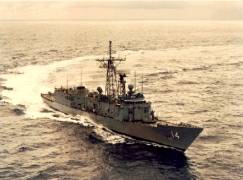 | 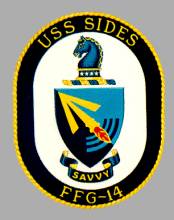 | 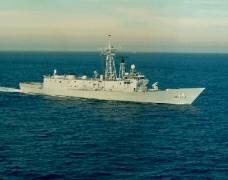 |
USS SIDES was the eighth guided missile frigate in the OLIVER HAZARD PERRY-class and the seventh "short hull" version in her class. USS SIDES was the first ship named in honor of Admiral John H. Sides.
In 1988, while deployed to the Arabian Gulf, SIDES completed a record 32 safe transits of the Strait of Hormuz while escorting oil tankers in and out of the volatile Gulf region. The ship also participated in combat operations as part of Operation Praying Mantis, the US retaliation in response to the Iranian mining of USS SAMUEL B. ROBERTS (FFG 58).
In 2002, SIDES participated in the war on terrorism, conducting maritime operations in support of Operations Noble Eagle and Enduring Freedom during her last deployment. Also in 2002, she led a combined U.S.-Australian task group in defense of strategic interests in the Indian Ocean.
A decommissioning ceremony at Naval Station San Diego on February 15, 2003, marked the end of USS SIDES' 21-year naval career. Shortly afterwards, SIDES was formally decommissioned and entered the Inactive Reserve Fleet at Bremerton, Wash., on February 28. Initially planned for a foreign military sale, the Navy sold the SIDES for scrapping on December 15, 2014. In June 2015, the SIDES arrived at Southern Recycling at Sulphur, La., and was subsequently scrapped.
| General Characteristics: | Keel Laid: August 7, 1978 |
| Christened: May 19, 1979 | |
| Commissioned: May 30, 1981 | |
| Decommissioned: February 15, 2003 | |
| Builder: Todd Pacific Shipyards Co., Los Angeles Division, San Pedro, Ca. | |
| Propulsion system: two General Electric LM 2500 gas turbines, two 350 Horsepower Electric Drive Auxiliary Propulsion Units | |
| Propellers: one | |
| Blades on each Propeller: five | |
| Length: 445 feet (133.5 meters) | |
| Beam: 45 feet (13.5 meters) | |
| Draft: 24,6 feet (7.5 meters) | |
| Displacement: 4,100 tons | |
| Speed: 28+ knots | |
| Aircraft: one | |
| Armament: one Mk 13 guided missile launcher (36 Standard (MR) and 4 | |
| Crew: 17 Officers and 198 Enlisted |
Crew List:
This section contains the names of sailors who served aboard USS SIDES. It is no official listing but contains the names of sailors who submitted their information.
USS SIDES Cruise Books:
About the Ship's Coat of Arms:
 The Shield:
The Shield:
The light blue on the shield of the coat of arms is symbolic of the hours of daylight and dark blue of the night. Together they connote the 24 hour watch and the vigilance required of warships at sea. The three arcs on the light blue suggest the very high frequency radio waves of radar, those on the dark blue symbolize the acoustic waves used in sonar to detect submerged objects. The broad arrow represents a missile on course to its target.
The Crest:
Blue and gold on the crest, are the colors associated with the Navy. The scaled horse's head, alluding to the heraldic sea horse, represents a knight, one of the pieces in the game of chess, suggesting at once the personal reputation of Admiral Sides as a man of knightly character and integrity and as a naval officer experienced in the strategies of sea warfare. The mullets, heraldic symbols related to the spurs of a knight, symbolize the four star rank attained by the Admiral.
About the Frigate’s Name, about Admiral John H. Sides:
A native of Roslyn, Washington, Admiral Sides received his commission from the U.S. Naval Academy, having graduated with distinction in the class of 1925. His early sea tours were served principally aboard battleships. While ashore he pursued development of his specialty - ordnance - First, in 1942, as Chief of Ammunition and explosive section of the Bureau of Ordnance; then in 1948 as Deputy to the Assistant Chief of Naval Operations for Guided Missiles; in 1951 in the Office of the Director of Guided Missiles, Office of the Secretary of Defense; and, most notably, in 1952, as Director of the Guided Missile Division, Office of the CNO, from which he director the Navy's Guided Missile Efforts for almost four years.
Admiral Sides at sea commands include: Commander Mine Division Eight (1944), Commander Destroyer Squadron Forty-Seven (1945), USS ALBANY (1950), and Commander Cruiser Division Six (1956).
On August 31, 1960, he was appointed Commander in Chief, U.S. Pacific Fleet, and served in that capacity until 1963 at which time he retired from active duty. He passed away April 3, 1978 leaving his spouse, the former Virginia E. Roach and daughter, Mrs. Joanne Savina Sides Watson.
USS SIDES Image Gallery:
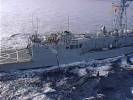 | 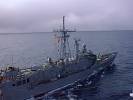 | 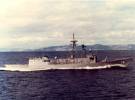 | 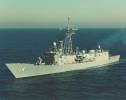 | 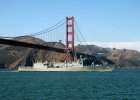 |
The photos below were taken by me and show the SIDES and her sistership GEORGE PHILIP (FFG 12) laid-up at Bremerton, Wash., on March 14, 2010.
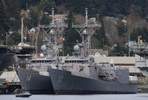 |  |
The photos below were taken by me and show the SIDES and her sistership GEORGE PHILIP (FFG 12) still laid-up at Bremerton, Wash., on May 13, 2012. Both ships have been moved from the pier to an anchorage in Sinclair Inlet off the naval shipyard.
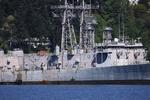 | 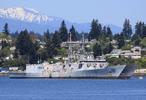 | 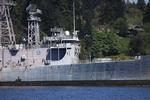 | 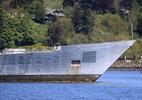 | 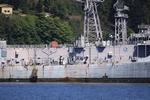 |
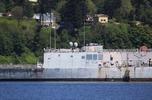 | 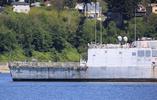 | 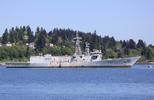 | 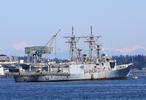 |  |
 Back to Frigates list.
Back to Frigates list.  Back to ships list.
Back to ships list.  Back to selection page.
Back to selection page.  Back to 1st page.
Back to 1st page.